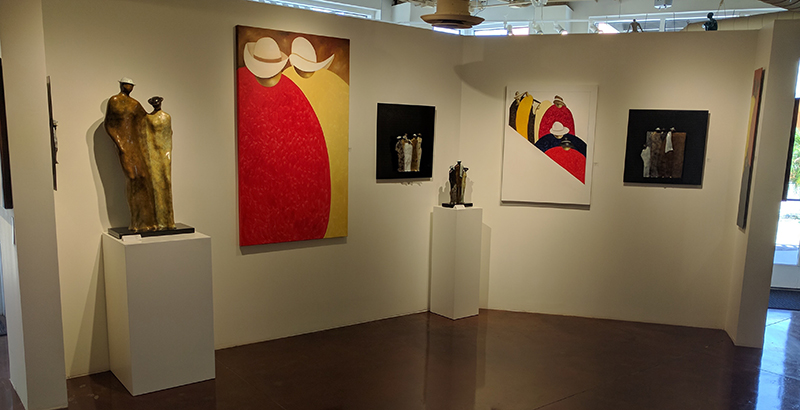
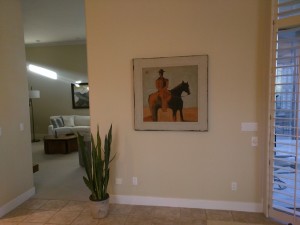
Two recent sales both occurred in what I consider to be hotspots in the gallery. What do I mean by “hotspots”? These are areas of the gallery that tend to generate more sales activity than other areas. Some of you may have experienced this in your galleries before or at art festivals or open studio tour events – there seem to be certain areas that generate more interest and activity, no matter what is showing there.
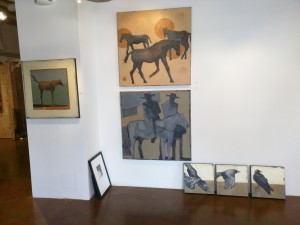
What I find particularly interesting about the hotspots in my gallery is that they aren’t necessarily in the areas where you might logically expect to find them. Yes, there are some major walls near the entrance that get a lot of attention, but there are also hotspots around corners and in the back quadrant of the gallery. My gallery, at 2300 square feet, isn’t huge, but I’ve tried to break up the space in a way that invites visitors to explore and allows me to show a good amount of art in an optimal way.
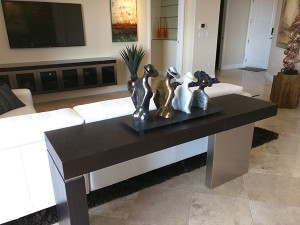
Some hotspots are artist dependent. For example, I had one wall off of which I was selling an artist’s work like hotcakes for several months. I started to worry that the gallery would get boring if I kept her work there forever, so I moved her to what I felt was a more prominent wall and gave her more space. Sales promptly dropped off. Interestingly, the work I put on the wall to replace the first artist’s work also didn’t sell. Guess what’s back on that wall?
Unfortunately I haven’t been able to come up with a satisfying hypothesis about why a particular area will attract more attention. I suspect that some of it has to do with lighting, some with the scale or prominence of a wall, but, as I mentioned above, some hotspots seem to be in corners and well off the beaten path. I can only conclude that to some degree, there are some deep, underlying crowd psychological factors driving buyers to certain walls and pedestals.
Since I can’t come up with a scientific explanation for the hotspots, my reaction to these sale-generating spaces feels a lot like superstition. I try not to think of our hotspots in a supernatural way, and I try to work to optimize every space to generate sales from every cubic inch of the gallery.
Here are some ideas I’ve had about reacting to these hotspots, and ideas that might help you better deal with them in your space.
- Know your hot(and cold)spots. They say that knowing is half the battle, and that’s certainly the case here. If you know an area tends to generate more activity, you can optimize your display to generate more revenue. Which leads to number 2:
- It makes sense to place your most impressive and most expensive work in the spaces most likely to generate sales.
- Rotate your inventory. This is especially important in a gallery where you want to generate sales for all of your artists, but it’s also a good idea in your studio or booth space. Rotating inventory frequently keeps things fresh and will help you gauge where your hotspots are more objectively. It can also help prevent hotspots from going cold, which can happen if your inventory is stagnant.
-
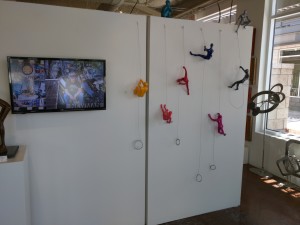
This wall by our entry was underperforming, so we put a video monitor up and these climbers by Ancizar Marin. Now the wall is doing great! Find ways to warm up cold spots. If we have an area that doesn’t seem to generate as many sales, I’ll try to liven the area up. I’ll give the area more light, place an artist there whose work is more colorful or energetic to draw attention to the space.
I should be clear that what I’m talking about in the post are trends. Hotspots don’t guarantee sales, and we’ve certainly sold art from every wall, nook, and cranny in the gallery during the time we’ve been in our current location. Still, I’ve found it helpful to pay attention to the flow of sales in each area of the gallery.
What Do You Think?
Have you experienced sales when your work has been displayed in a certain area of a gallery or booth? How have you reacted to hotspots? Share your thoughts, questions, and experiences in the comments below.
Years (okay, decades) ago, when I was at one of my first art shows, the artist next door came over to congratulate me on a sale she had overheard. She was appalled when she saw that the space from which that piece had sold was still empty. She said I needed to fill it immediately, and when I didn’t rush to do that, she grabbed a piece from another wall and hung it there, explaining that when a sale occurs, there is an “aura” left behind by that event, drawing other people to that same spot.
My feet are firmly on the ground in this space and time, and I made light of her actions. But, within the hour, another sale was made from that same location.
Forty years later, I still don’t read horoscopes, visit psychics or carry a rabbit’s foot…but I always. always pay attention to those sweet spots, and say a soft “thank you” to the sweet invisible graces as I am filling in the empty space.
Great story Louise. Thanks for sharing.
I love your story! Thanks for sharing. I’ll hold the same attitude now when this happens.
For years I worked retail and for some time I worked for the retail Giant Ikea. Every single week they walk the floor with their stats books, examine sales locations and rotate the product if they feel the location was under preforming. They have “hots spots” and terminology/criteria for products in particular locations all over their stores. Pretty fascinating. Did you know that once you descend from the upstairs showroom to the main level you arrive at “open the wallet?” An area which encourages shoppers to pick up a bag or cart while being surrounded by inexpensive but always needed items. To them it is a science and they have done the research!
I used to be a manager at Starbucks. As anyone knows, their ability to generate sales is, to use Jason’s term, “supernatural.”
With Starbucks, every inch of the store is obsessed over. They have a graphic schematic detailing how to arrange their seasonal merchandise and promo down to the inch. They call this schematic the “Siren’s Eye” because the placement, not the merch, will drive sales like a siren enchanting a sailor into its lair.
This is so important that post after hours setup, someone from corporate will come the next morning with tape-measure in hand to adjust the layout. A quarter inch can make a difference.
I’ve heard they develop the Siren’s Eye by conducting hypnosis based focus groups where they move around a piece of merch in a replica of their cafes until the group proclaims they have to buy it, perfecting the siren effect.
I tested this with the cafe’s hottest spot.
Occasionally, they’d have a merch fail with some ugly mug that no one in their right mind would buy, so they’d offer an Amazon gift card to the manager who sold the most of the failed merch. I’d cheat and blaspheme against the Siren’s Eye by moving the failed merch into the hotspot. The ugly mug would sell out within an hour and I’d get that Amazon card every time.
I’ve seen so many examples of things like this at Starbucks that I began to question human free will.
Yes, hotspots are real (as are dead spots) and its why real estate people keep saying “location, location, location” – there’s even a Chinese art called Feng Shui which deals solely in the arrangement of objects within a room or enclosed area or even with the arrangement of buildings within a city to produce harmonious energy flow. Though ascertaining exactly what produces a hot-spot is extremely difficult to ascertain and it may vary for how each individual artwork reacts with the space itself, I would say that dramatic lighting or resonant acoustics play a big part in making a hot-spot. But here’s the thing I’ve noticed – the things that create a hot-spot must be completely subtile, so their effect plays on the unconscious perception – if any effect you use to attempt to create a hot-sport is consciously discernible to the viewer, it absolutely will not work
Very interesting and true, I also liked your “3 tips”.
I just had a large art show in 1/2 of a new lovely hotel’s ballroom, 2,200 Sq. Ft., the room and my show were fabulous, my 1st large show. I am 83 years old, 30 years ago I took 2 nite art classes, painted for 1 year, my very 1st real painting jurried in to the Del Mar Fair, they had like 6,000 entries, only a few hundred accepted. Then I did nothing with art until 2 years ago, now have approx.140 paintings. My web site is
vividartbygail.com. Need to market my work, but limited funds. Thank you, Gail
Enjoying your comments, ideas,etc, sorry got a little wordy.
A friend uses this theory at art fairs and in her studio. She says that if you sell a piece, you should move another piece into that spot immediately because it has positive energy from that sale. It hasn’t worked for me yet, but she swears by it.
There’s a particular space in my father’s living room where his potriat is more magical and real
Than anyother space in the same room.
Though dead, it’s believed that his spirit duells and protecting the house from this corner of the room.
I witnessed it also as a teenager Alterboy in Church,not all spaces in the Church can properly host certain statues unless it’s formal space.
Your story is a confirmation that there is a spritual relationship between spirits duelling in particular spaces,and objects hosting spirits.just my thinking.
If each painting has unique emotional resonance that connects to the viewer then subliminal staging can reinforce that. As in, putting a contemplative piece in a quite spot where the viewer can be undisturbed, or a dynamic piece where a viewer can feel free to dance with it. Maybe, if an artist’s ‘style’ dependably evokes a particular emotional resonance, their paintings are best on a particular wall.
Interesting theory!
Nowadays, when I think I have finished a piece, I hang it on walls in the house that will give me glimpses or long looks. I rotate them. There are some spots where some paintings come alive and others where those same paintings just say “you haven’t finished me yet”. I suspect that the comment about the energy of the work complementing the energy of the space is spot on.
The comments as well as the OP have made this a particularly fascinating discussion!
It would be cool if we could find the “scientific” explanation for even some of it.
This post is much later than the one above. I have one painting which hung on a wall that is normally an eye catcher. That painting just looked muddy in that location. I considered it a failure. I rotated it to another wall because I needed to balance a wall. A short while later, not thinking about the painting, I placed a lamp under it (on a table). That painting has become a family favorite. The lighting seems to compliment the direction of the sun in that skyscape.
Now, when I look at that painting in the evenings, I experience the awe I felt when glimpsing the eastern storm that long ago morning as I left for work.
I suspect those who hang the paintings create hotspots. The sales force are also artists; their medium is the art works and the space.
Yes Jason – I know exactly what you’re talking about with gallery ‘hot spots’!
My Denver gallery owner moves our artwork around to different locations every 3 months or so. I had my artwork on the very front ’Feature wall’ for 3 months ( right behind the staff sales desk) with high ceilings and natural day light, in addition to the gallery lighting. Nothing sold😢 Then my work was rotated downstairs (which has a totally rustic vibe with rock walls and gives a nice cozy ambiance. I sold 3 paintings (some of the same that were hanging upstairs) within a short period of time!! My hypothesis is, people aren’t as comfortable looking at artwork when the sales staff is sitting at the front desk!??? It’s just a guess — but I’m still in my little corner and I’ve continued to sell and get commissions! Yay!
The first photo shows that L-shaped alcove. You’ve placed the art in a flowing, cascading fashion regarding the levels. That creates serenity and is appealing when viewing art.
Very intriguing comments/advice! I am 80 now and painting is my ‘Out’! I really enjoy it, and in reading these comments, I find I may need to hang the ones I’ve completed in order to make ready for this year’s display at the County Fair. Thanks again to all the people that have commented!
I am a believer. And it was reinforced when I lived in New York across the park from the Met Museum. There was a Maori show coming and it was a big thing because they believe that everything has “spirit.” The show almost did not open when the elders became concerned about the precious works off in New York, unprotected. Fortunately it turned out that one of the Museum guards was a Maori and the exhibit was put into his care and protection. Those of us who went to see it were mightily aware of the aura and spirit of the art. Life is full of mysteries. If you’ve ever seen your own work hung in a grim space, you’ll understand.
There may be some element of the psychological state of the gallery viewer on their journey through the space. They may be enticed to enter by some large, bold, beautiful, work near the entrance, but can not fully attend to it once they enter, as their thoughts are distracted by initially scanning the entire space to orient themselves, plan their route through the space and feel a bit visually overwhelmed by the number of items they will be viewing before leaving. As they get further along their journey, they will eventually be able to give more full attention to the individual work in front of them, before eventually getting mentally fatigued towards the end, and more ‘going through the motions’ to just finish seeing everything. There is that sweet spot in the attention span where they may be more open to appreciating the work, and lingering with each piece a bit longer. Of course, other factors like lighting, privacy, and space, will give them the proper environment to fully attend to the subject.
Has anyone applied the principles of Feng shui (https://en.wikipedia.org/wiki/Feng_shui) sometimes called Chinese geomancy to organize the “flow of energy” in their gallery?